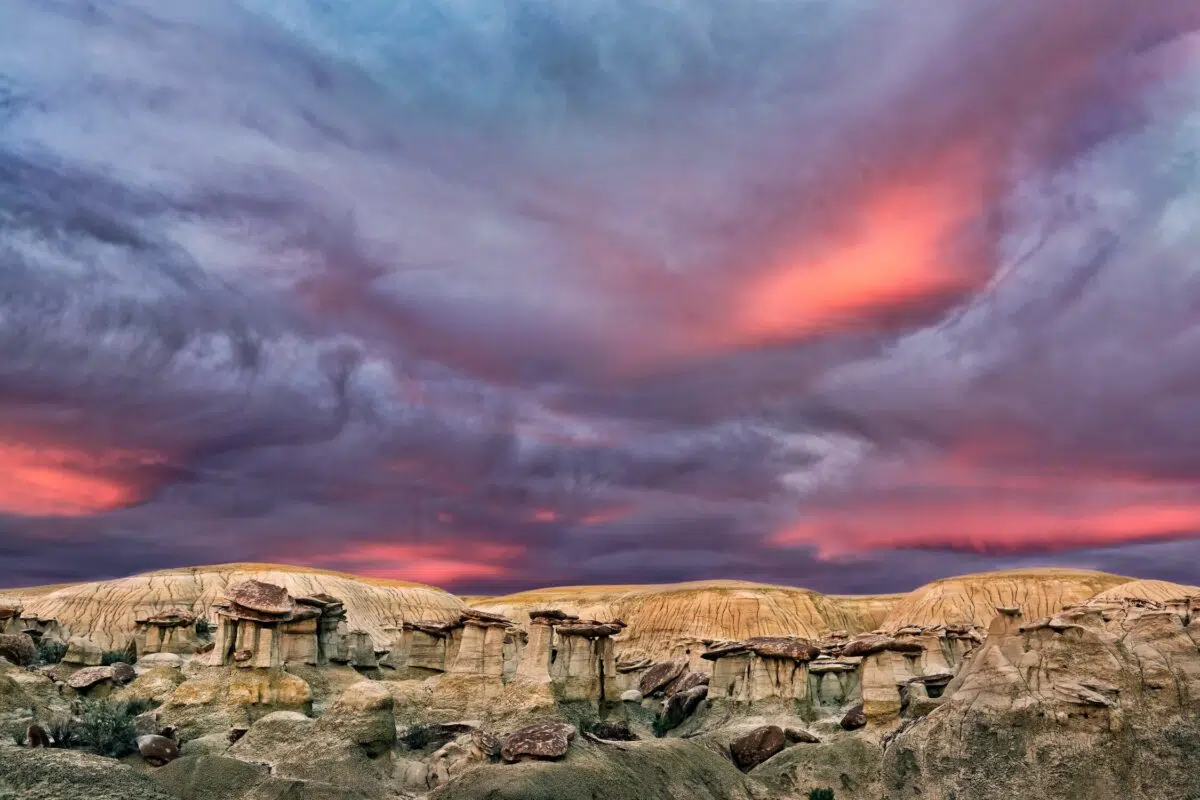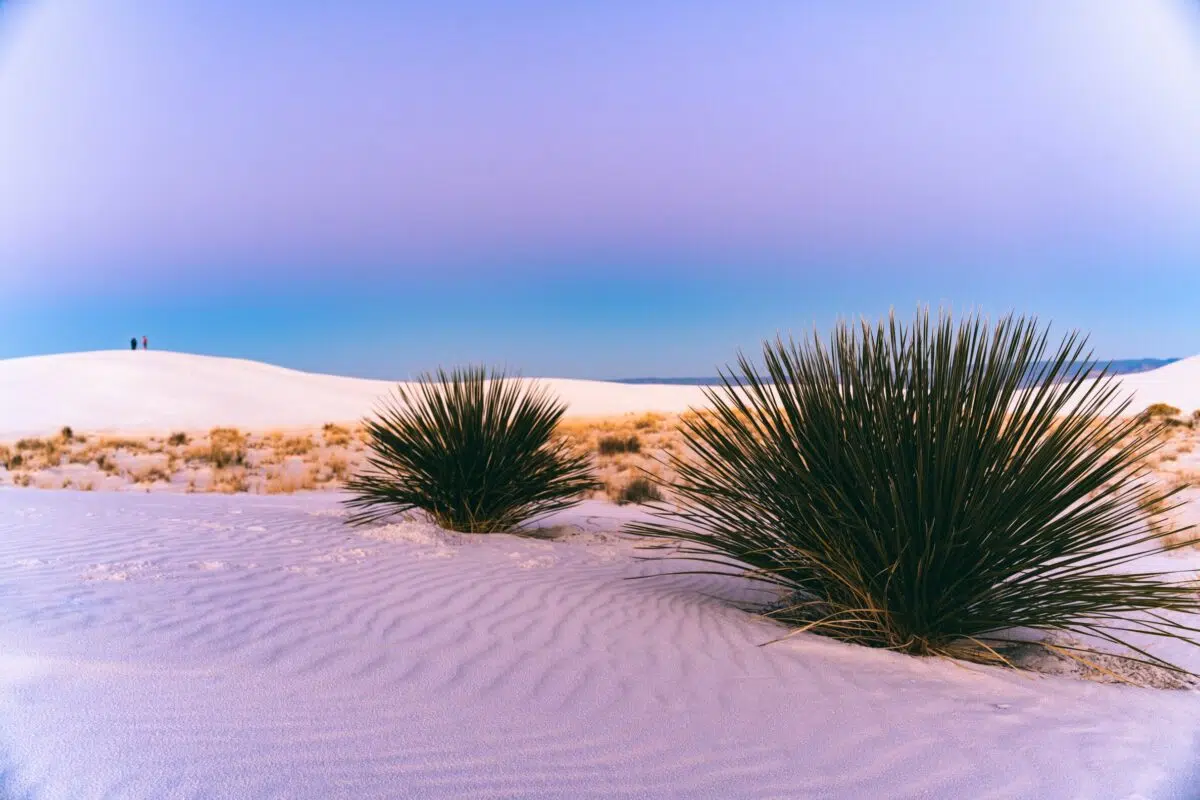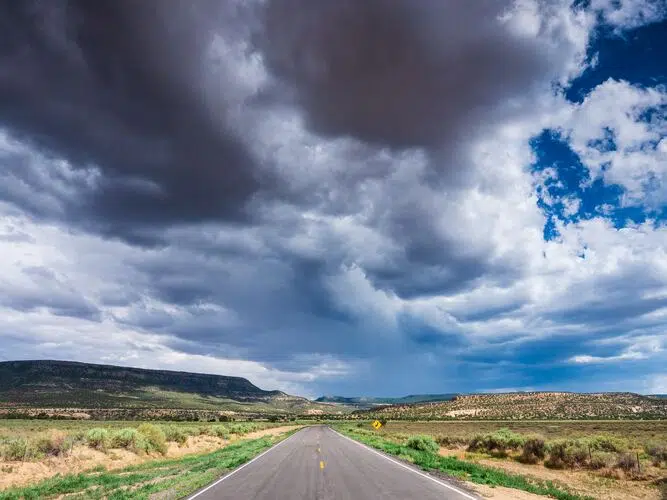
Have you ever wondered why New Mexico is called the “Land of Enchantment?” Although the beautiful state typically gets overshadowed by its neighbors, New Mexico houses two national parks, nine national monuments, three national historical parks, and one national preserve.
It harbors three UNESCO World Heritage Sites, more than any other state in the country. Let’s dig deeper into the New Mexico National Parks so you can plan your journey to enchantment.
New Mexico National Parks
New Mexico’s two national parks are unique. One is underground, while the other is a beach without an ocean. Both are spectacular.
Carlsbad Caverns National Park
Location: 727 Carlsbad Caverns Highway, Carlsbad, NM 88220
I saw Carlsbad Caverns National Park for the first time as a teenager during a family vacation to explore the western United States. Although we stopped at many iconic places on the trip, Carlsbad Caverns was my favorite. Seeing a hidden world of giant cave formations blew my mind and ignited my passion for our national parks.
I returned to Carlsbad Caverns many years later with my wife. Again, the magical underground world stirred the same emotions.
Carlsbad Caverns National Park, recognized as a UNESCO World Heritage Site, quietly lies 750 feet underground within the Guadalupe Mountains in the Chihuahuan Desert in southeastern New Mexico. Peering down into the cave entrance, your heart races with excitement. The fun is about to begin.
Hike the 1.25-mile Natural Entrance Trail from the cave’s mouth to the main attraction, the Big Room. The Natural Entrance Trail is a fantastic experience but is steep, with many switchbacks. Accordingly, it is rated strenuous. If you prefer, you can ride an elevator to the Big Room.
The Big Room houses many cave formations, some tiny and delicate, others massive and sturdy. Prepare to pick up your jaw from the ground due to the size and scope of the cavern and the beauty of the stalactites and stalagmites. The Big Room Trail is 1.25 miles long but is level and rated easy. Hiking or walking inside the Big Room is pure joy as you marvel at God’s masterpieces.
A thrilling experience, in the evenings from late May through October, you can watch thousands of bats fly out of the cave, swooping to the skies for food.
Interesting Facts About Carlsbad Caverns National Park
- The Big Room spans over 8 acres, North America’s largest, readily accessible cave chamber.
- Cave formations develop from water slowly dripping onto limestone, one drop at a time. Structures started more than 500,000 years ago and continue to grow today.
- The temperature in the cavern consistently remains 56 degrees Fahrenheit.
- Many visitors mistakenly believe they see bats flying near the cave’s entrance when hiking the Natural Entrance Trail. These are cave swallows. Bats prefer deeper, darker cave sections and are more active at night.
White Sands National Park

Location: 19955 Highway 70 West, Alamogordo, NM 88310
A vast field of glistening, wavy dunes, White Sands National Park nestles between two mountain ranges near Alamogordo in southern New Mexico. The dune field is so white you will swear it is snow. Discovering so much white sand without ocean waves rolling ashore is odd yet breathtaking.
The park offers opportunities for leisurely activities like a boardwalk stroll, picnic lunch, photography session, or playing in the sand. Or, you can tackle a challenging 5.0-mile hike along Alkali Flat Trail, trudging up and down dunes the entire way. If you have ever tried to climb dunes of loose sand, you know how exhausting this is. However, you gain a rewarding view each time you crest a dune.
You can partake in one of the most fun activities in the United States park system, sand sledding. Riding a plastic saucer down the sand slopes is a thrill for people of all ages. Kids love it, and adults become kids again.
The park offers ranger-led full-moon hikes and full-moon nights for unique evening experiences. Observe the desert under the moon’s glow and hear animals emerge for food during the night’s more comfortable temperatures.
Interesting Facts About White Sands National Park
- The gypsum dune field spans 275 square miles, with the national park preserving more than half of it. On a clear day, you can see White Sands National Park from a plane if you fly into or out of El Paso.
- Most beach sands consist of quartz, but the sands here comprise gypsum. Unlike typical beach sand, it does not absorb heat. You can walk barefoot without burning your feet.
- Dunes Drive, the park’s only road, spans 8 miles to the back of the park. Although the first five miles contain pavement, the last three are hard-packed sand. It is similar to driving on snow.
New Mexico National Monuments
The state’s national monuments preserve culturally significant sites and beautiful landscapes, honoring the legacy of great civilizations that once thrived there.
Aztec Ruins National Monument
Location: 725 Ruins Road, Aztec, NM 87410
The Aztec Ruins National Monument in northwestern New Mexico showcases preserved structures constructed and occupied by Pueblo Indians more than 900 years ago. Not only do you get a glimpse of ancestral Pueblo Indian life, but you gain a connection to the cultural heritage of American Indians today.
Walk the 0.5-mile trail through the ruins and observe artifacts like pottery and jewelry in the park’s museum. Gaze upon the Pueblo Great House with more than 400 masonry rooms and original roof timbers. The intact T-shaped doors and ancestral Pueblo rooms transport you back to a thriving community that survived over two centuries.
See the reconstructed Great Kiva, a 40-foot diameter semi-subterranean religious center. Explore the Native Plants Walk and Heritage Garden areas where park staff and volunteers grow traditional plants and crops utilized by people in the Southwest for thousands of years.
Walk part of the Old Spanish National Historic Trail to historic downtown Aztec. The path marks the first recorded trade caravan from Santa Fe to Los Angeles, California.
Interesting Facts About Aztec Ruins
- Early European settlers incorrectly believed the ruins belonged to the Aztecs of Mexico and named the area accordingly.
- The site is approximately a 1.5-hour drive from Chaco Culture National Historical Park, a UNESCO World Heritage Site. Due to its proximity, Aztec Ruins National Monument gets recognized as part of the World Heritage Site.
- You can see the fingerprints of workers in the mortar of the Pueblo Great House.
Bandelier National Monument
Location: 15 Entrance Road, Los Alamos, NM 87544
The Bandelier National Monument, near Los Alamos in northern New Mexico, comprises more than 33,000 acres of rugged yet beautiful landscapes of canyons and mesas. It preserves evidence of human life going back more than 11,000 years.
Tour ancestral Puebloan cliffside dwellings that blend with the environment. A fun and educational experience, you will encounter ladders where you can climb into human-carved nooks. You will discover petroglyphs and rock paintings while exploring the dwellings and kivas.
The park offers many hiking trails for day hikes and backpacking excursions. Experience the Pueblo Loop Trail, the park’s most popular hike, where you climb ladders and see significant sites, including Big Kiva, Tyuonyi, Talus House, and Long House.
Interesting Facts About Bandelier National Monument
- Bandelier National Monument protects the ancestral homelands of at least 23 tribal nations.
- The monument’s name honors anthropologist Adolph Bandelier, the first person to study and report on the dwellings in the area.
- Bandelier sits on the outer slope of Valles Caldera, a depression formed from a collapsed volcano over a million years ago.
- Rock formed by volcanic ash, called tuff, is soft and porous, thus allowing the ancestral Pueblo people to use hand tools to carve openings in the cliff and use tuff blocks to create dwellings.
Capulin Volcano National Monument
Location: 46 Volcano Highway, Capulin, NM 88414
Near the Colorado border in northeastern New Mexico, the Capulin Volcano National Monument is an extinct cinder cone volcano highlighting the area’s unique geology. It is part of the 8,000-square-mile Raton-Clayton Volcanic Field.
The park provides an excellent opportunity if you love volcanoes or enjoy unique hiking experiences. Hike the 1.0-mile loop, Crater Rim Trail, to the peak, 8,182 feet. Then take the Crater Vent Trail to the crater’s bottom. Although only 0.2 miles each way, the Crater Vent Trail has an elevation change of 100 feet. Cross one of the volcano’s lava flows by hiking the 1.0-mile Lava Flow Trail at the base.
Capulin Volcano National Monument is recognized as a Gold Tier Dark Sky Park by the International Dark Sky Association. Stay after sunset to savor some of the best stargazing in the country.
Interesting Facts About Capulin Volcano Monument
- The volcanic rock is between 56,000 and 62,000 years old.
- You can drive to the crater rim. Although the road is just two miles long, the drive takes ten minutes.
- On a clear day, you can see land formations from four states from the rim: New Mexico, Colorado, Oklahoma, and Texas.
El Malpais National Monument

Location: 1900 East Santa Fe Avenue, Grants, NM 87020
El Malpais National Monument in western New Mexico harbors one of the country’s most complete sequences of lava flows. Discover unique geological wonders, including lava tube caves, sandstone bluffs, cinder cones, and spatter cones.
Since lava flows created a rugged landscape, no roads exist inside the park. However, you can admire the area’s geological features through scenic drives along the park’s borders, overlooks, and short trails.
For those who love hiking, the park offers many moderate and strenuous trails over its rugged lava-formed landscapes. Although the park permits dogs on many of its courses, lava flows resulted in rough surfaces with sharp, jagged areas that pose injury risks to our furry friends.
A caving permit is required to enter any lava tube within the park. Permits get issued on a first-come, first-served basis. A maximum of ten people may enter each cave daily. You must have a partner to enter a cave.
El Malpais National Monument is an excellent stargazing spot due to the black lava rock on the surface and minimal light pollution. You can observe a black sky sprayed with gold glitter as night settles in.
Interesting Facts About El Malpais National Monument
- El Malpais translates to “badlands” in English.
- The National Park Service (NPS) is in the early stages of developing an application to designate El Malpais as an International Dark Sky Park.
- Approximately 30 miles of the Continental Divide National Scenic Trail wind through the park.
El Morro National Monument
Location: Mile Marker 44.6 Highway 53, Ramah, NM 87321
It has been said many times, “Water is life.” El Morro National Monument echoes the sentiment. Along an otherwise dry and dusty east-west path, the site provided a reliable water source for ancestral Puebloans, Spanish, and American travelers. Due to the hidden watering hole at the base of a prominent sandstone bluff, the area became a campsite for hundreds of years.
Beyond the oasis, what makes the monument unique? Travelers left their mark with signatures, inscriptions, messages, symbols, and dates on a sandstone wall known as Inscription Rock.
The park offers exhibits in its visitor center and two hiking trails. Inscription Trail is a 0.5-mile paved path with gradual intermittent slopes that takes you to the watering hole. If you want a longer hike, instead of looping back to the visitor center, continue along the 2.0-mile Headland Trail. The partly paved trail contains a few steep slopes and is rated moderately strenuous.
Interesting Facts About El Morro National Monument
- Inscription Rock contains more than 2,000 petroglyphs and inscriptions.
- Because Inscription Rock consists of soft sandstone, travelers could easily carve messages onto it. The sandstone’s softness is also why many of the signatures have faded.
Fort Union National Monument
Location: 3115 New Mexico Highway 161, Watrous, NM 87753
Resting in northeast New Mexico, about 100 miles from Santa Fe, Fort Union National Monument contains the remnants of a 19th-century adobe fort along the Santa Fe Trail. After New Mexico became a United States territory, the historic fort defended New Mexico, its inhabitants, and trade routes.
Take a self-guided 1.25-mile walk on the park’s interpretive trail to view the entire frontier post and learn about its fascinating history. If you prefer a shorter walk, you can take a 0.5-mile course to see a portion of the fort.
Interesting Facts About Fort Union National Monument
- Fort Union served as a frontier post from 1851 to 1891.
- During its time, Fort Union was the region’s most extensive American military frontier post.
- It had broad streets and intersections but no stockades, so it looked like a frontier village.
- The site preserves the second of three forts built in the area. You can also see the ruins of the third fort.
Gila Cliff Dwellings National Monument
Location: 26 Jim Bradford Trail, Mimbres, NM 88049
For thousands of years, nomads passing through southwestern New Mexico seeking temporary shelter holed up in caves above Cliff Dweller Creek. The Mogollon people made it their home in the 1200s. Gila Cliff Dwellings National Monument protects the magnificent rooms, pottery, and artifacts.
Explore artifacts in the visitor center and learn about the Mogollon people and their homes. Then hike to and through the impressive dwellings for a firsthand look.
Interesting Facts About Gila Cliff Dwellings Monument
- Although the Gila Wilderness comprises over 400 miles of hiking trails, the 1-mile loop to the monument is the most popular.
- The Mogollon people left the dwellings around 1300.
- Although the drive from Silver City is 44 miles, it takes 1.5 to 2 hours to reach the park due to the winding mountain roads.
- Cell phones do not work anywhere in the park.
Petroglyph National Monument
Location: Unser Boulevard NW at Western Trail, Albuquerque, NM 87120
Just west of Albuquerque, Petroglyph National Monument holds one of North America’s most extensive petroglyph sites with symbols carved into volcanic rocks by Native Americans and Spanish settlers, dating back 400 to 700 years. The monument houses 17 miles of bluffs showcasing thousands of sacred symbols of cultural expression.
Although the park offers four hiking trails, only three yield views of petroglyphs. Boca Negra is a short hike that takes about 1 hour and delivers 100 petroglyphs. Rinconda Canyon has about 200 petroglyphs and takes about 2 hours. You can see about 400 petroglyphs along Piedras Marcadas Canyon in 1.5 hours. Although the Volcanoes Day Use Area has no rock art, the 2-hour hike yields spectacular views of volcanic geology.
Interesting Facts About Petroglyph National Monument
- Archaeologists estimate the site contains 25,000 petroglyphs.
- Unlike most national park sites, the area by the information center does not house any trails. You must drive to access the trailheads and petroglyphs.
Salinas Pueblo Missions National Monument
Location: 105 South Ripley Avenue, Mountainair, NM 87036
Nestled in central New Mexico, Salinas Pueblo Missions National Monument presents three major sites symbolizing the relationships and interactions between Indigenous peoples and early settlers, some cordial, others tense. Tompiro and Tiwa Native Americans inhabited the land before Spanish Franciscans settled into the area for missionary work. The site preserves partially excavated pueblos and three mission churches at Quarai, Abo, and Gran Quivira.
Explore the tales of diverse cultures. Learn about a unique time in history when the salt trade and spirituality became driving forces for these different societies. Although the different cultures clashed, they ultimately borrowed goods, ideas, and beliefs.
Each site offers an interpretive trail and opportunities for picnicking and photography. The national monument is recognized as an International Dark Sky Park and holds annual astronomy events.
Interesting Facts About Salinas Pueblo Missions National Monument
- Spanish explorers hoped to find gold in the area but found salt instead. They named the area Salinas, or “salt mines.”
- Gran Quivira was the largest of the three pueblos, housing 1,500 to 3,000 people at its peak.
- Legends say Billy the Kid visited Gran Quivira and was encouraged by a friend to damage the cross atop the church ruins. He recognized it as an artifact and left the site unscathed.
New Mexico National Historical Parks

The New Mexico national historical parks preserve some of our country’s most mysterious and fascinating history.
Chaco Culture National Historical Park
Location: 1808 County Road 7950, Nageezi, NM 87037
Resting in northwestern New Mexico, Chaco Culture National Historical Park is a UNESCO World Heritage Site and an International Dark Sky Park. It holds the remnants of a mysterious, ancient world centered on commerce, culture, and organization. Pueblos and structures showcase an ancestral Puebloan civilization’s architectural and engineering prowess.
Take a self-guided auto tour on the 9-mile Canyon Loop Drive with six significant viewing sites. The park offers hiking trails and camping if you have more time. Pueblo Alto Trail, a 5.4-mile loop, takes you through backcountry ruins, Chacoan buildings, and multiple overlooks. The trail’s highlight is an aerial view of Pueblo Bonito from the top of a mesa.
Pueblo Bonito, the center of the Chacoan world, is the most critical site in Chaco Canyon. It is accessible by a short trail from Canyon Loop Drive. Some anthropologists compare its archaeological significance to Stonehenge and Machu Picchu.
Chacoans used unique masonry techniques for the time and constructed great houses with multiple stories and hundreds of rooms. The architectural design and scale far exceeded anything they had previously built.
Interesting Facts About Chaco Culture National Historical Park
- Chacoans constructed great houses with thick walls of sandstone and mud mortar.
- Some buildings took decades or even centuries to construct. For example, Chacoans built Pueblo Bonito in stages from AD 850 to AD 1150.
- Chacoans built roads to connect significant sites, an impressive feat considering the area’s harsh environment.
- The decline of Chaco Culture remains a mystery. Historians believe a prolonged drought is a possible reason.
Manhattan Project National Historical Park
Location: 475 20th Street, Los Alamos, NM 87544
The Manhattan Project was a top-secret government program where the United States endeavored to create and use the world’s first atomic bombs in World War II. It occurred at three central locations: Los Alamos in northern New Mexico, Hanford, Washington, and Oak Ridge, Tennessee.
Los Alamos was the perfect spot for the secret laboratory, a remote location yet close enough to Santa Fe for resources and transportation. At Manhattan Project National Historical Park, you can explore the history of the places and people behind the fascinating Manhattan Project.
Nearly all the park’s historic properties sit “behind the fence” within a secure Department of Energy site. A special guided tour can only access the facilities, typically offered three times a year. You will see Pond Cabin, Battleship Bunker, and the Slotin Building during the guided tour.
Interesting Facts About Manhattan Project National Historical Park
- The behind-the-fence tour lasts three hours, beginning and ending at the Bradbury Science Museum.
- Oakridge, Tennessee, housed the industrial complex to enrich uranium. The location later became the project headquarters.
- Hanford, Washington, contained an industrial complex to produce plutonium.
- Residents of these “secret cities” had limited connections to the outside world, making sacrifices for their patriotism.
- The Manhattan Project started the nuclear age, leaving a complex legacy with lingering moral and ethical questions.
Pecos National Historical Park
Location: 1 Peach Drive, Pecos, NM 87552
Resting 25 miles east of Santa Fe, Pecos National Historical Park preserves and honors an ancient trade route between the Sangre de Cristo Mountains and the Glorieta Mesa. A literal and figurative cultural crossroads, the path provided a corridor through the mountain pass for explorers, traders, immigrants, missionaries, frontiersmen, ranchers, tourists, soldiers, and more for thousands of years.
It is a must-visit park for history lovers, especially those who enjoy the American Southwest. The visitor center offers a film and a museum that takes you through the area’s history and archaeology. You can tour Pueblo and mission ruins and a Civil War battleground. The park includes a stage stop on the Santa Fe National Historic Trail, Route 66 history, New Mexico ranch history, and important sites of the Civil War.
Interesting Facts About Pecos National Historical Park
- You may discover relics on the ground while exploring the park. It is illegal to remove anything from a national park.
- Opening in 1821 after Mexico won its independence from Spain, the Santa Fe Trail passes directly through the park.
- Glorieta Battlefield Trail is a 7.5-mile drive from the park’s visitor center, behind a locked gate. You must first stop at the visitor center to obtain the gate access code. The trail is a fascinating portal to the Civil War in New Mexico.
New Mexico National Preserves
The state’s sole national preserve delivers unique geology and breathtaking scenery. It feels like a full-fledged national park in the making.
Valles Caldera National Preserve
Location: 39201 New Mexico Highway 4, Jemez Springs, NM 87025
More than a million years ago, a spectacular volcanic eruption in north-central New Mexico left a 13.7-mile wide circular depression upon the Earth’s face. Valles Caldera National Preserve showcases unique, breathtaking landscapes of vast meadows and winding streams between lush forests and spectacular mountain ranges. Although dormant, you can see signs of volcanic life, such as hot springs and fumaroles. The park teems with wildlife, including elk, prairie dogs, black bears, coyotes, and badgers.
Popular activities include hiking, biking, fishing, hunting, and scenic drives. In winter, you can enjoy cross-country skiing and snowshoeing. It is an International Dark Sky Park. Rangers offer full moon hikes and night sky viewing programs during new moons from June through October.
Interesting Facts About Valles Caldera National Preserve
- Valles Caldera National Preserve was a private ranch for over 150 years. Designated as a national preserve in 2000, many points of interest remain unmarked.
- The area harbors the state’s second-largest elk population. Visitors can go elk and turkey hunting in the park.
Bonus Sites To Visit
New Mexico offers some additional sites worth visiting due to their beauty or historical and cultural significance to the region.
Taos Pueblo
Location: 120 Veterans Highway, Taos, NM 87571
Although not a national park site, Taos Pueblo is the only living Native American community recognized as a UNESCO World Heritage Site and a National Historic Landmark. It is one of North America’s oldest continuously inhabited communities.
The adobe settlement nestles in the Sangre de Cristo Mountains in northern New Mexico. It comprises Pueblo Indian ceremonial buildings and dwellings. The 13th and 14th-century settlements feature multi-storied facilities in terraced tiers, some five stories high. You can learn about the community, its people, cultures, and architecture.
Four Corners National Monument
Location: 597 New Mexico Highway 597, Teec Nos Pos, AZ 86514
Sitting in Navajo Tribal Park, Four Corners Monument allows you to stand in four states simultaneously: New Mexico, Arizona, Colorado, and Utah. It may seem a bit touristy, but it is a unique experience. You also have an opportunity to learn about the culture and history of the Navajo people.
Guadalupe Mountains National Park
Location: 400 Pine Canyon, Salt Flat, TX 79847
I admit Guadalupe Mountains National Park sits in Texas rather than New Mexico. From Carlsbad Caverns, the Texas national park is an easy 45-minute drive on the same road, the National Parks Highway. It simply is too good of an opportunity to pass.
The Guadalupe Mountains National Park offers rugged mountain scenery and exhilarating hikes across its five districts. It contains the state’s highest point, Guadalupe Peak. However, the beauty and majesty of El Capitan will likely draw your gaze more frequently. Devil’s Hall, one of the most popular hikes, requires bouldering, leads you up a natural stone staircase, and leaves you feeling small between two steep canyon walls.
Wrap-Up: New Mexico National Parks
Deeply steeped in American history, lore, and culture and blessed with natural beauty, New Mexico national parks offer unique and rewarding experiences. It is time to pack your bags for adventure in the Land of Enchantment.
This article originally appeared on Savoteur.

Scott and Julie blog at Miles with McConkey. After nearly 30 years, they took a leap of faith to leave the corporate world to enjoy a life of travel and adventure. They hope to inspire you to find ways to travel more and enjoy life now.


